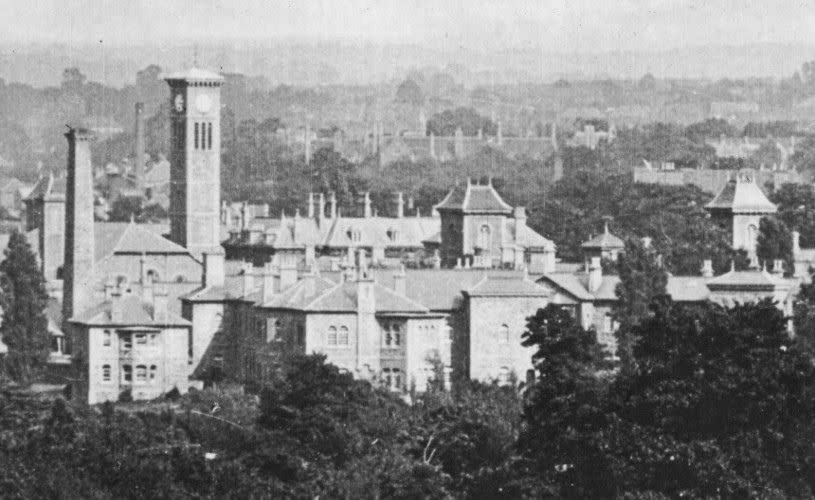Explore the fascinating and often surprising history of mental health care over time with Glenside Hospital Museum - a museum based within the grounds of what opened in 1861 as Bristol Asylum, continuing to support mental health in the area as Bristol Mental Hospital (1948-58) and then Glenside Hospital (1960-1994).
Its collection also incorporates artefacts from Stoke Park Colony for Learning Disabilities (1909-2000) and the First World War Beaufort War Hospital. This collection provides powerful human insight into the lives of those who lived and worked within the hospitals, highlighting the layers of history behind this place as it evolved from a place of psychiatric care to a museum.
The hospital and its collections also featured in series 3 episode 2 of the BBC Two television series ‘A House Through Time’ presented by Professor David Olusoga.
In the course of this article, the term ‘hospital’ will be used wherever possible when referring to the building’s title, as ‘Asylum’ is regarded as an antiquated term, with ‘Psychiatric Hospital’ the terminology typically used today. The 1959 Mental Health Act in fact required that the word ‘mental’ also be dropped from the title of psychiatric hospitals and hence the hospital became ‘Glenside’ in 1960. Currently, Covid-19 measures mean that the Glenside Hospital Museum is temporarily closed to the public… yet its forgotten history is always open to explore. This article will consider the past of the hospital as well as how you can access many of its archives virtually thanks to the museum, along with some fascinating facts


Image - Glenside Hospital Museum
In terms of the building where it is based, Glenside Hospital Museum occupies the Grade II listed former hospital chapel dating from 1881, full of beautiful stained glass windows that depict healing. The hospital building is still intact and restored by the University of the West of England, as it is their campus for Health and Social Care, recently training hundreds of people in how to nurse Covid-19 patients.
So what is the history of Glenside and why does it matter? Consideration of its development and evolution over time provides a valuable learning curve considering how mental health is treated both medically and in the attitudes of society; with mental health a subject of increasing public pertinence today.
The hospital itself was part of a growing number of psychiatric hospitals during the mid-19th century, following the then-named Lunatic Asylums Act of 1851, which ordered the compulsory creation of mental hospitals to take in the mentally ill poor. As a result of this law, between 1845 and 1888, 63 were built across the country, often to replace or upgrade existing mental health facilities, many of which were overcrowded and poorly regulated. In the case of Bristol, it was a crucial response considering that many of the mentally ill poor were still in a city centre workhouse, whilst the existing St Peter’s Hospital was already overcrowded. In turn, Bristol Corporation recognised that a purpose-built hospital for psychiatric care was required, and after much deliberation, the Fishponds area was selected as the location; at a distance from the city centre yet still well connected, with a local railway line nearby. The semi-rural location also had the advantage of local quarries which were used to source the stone for the building itself, with construction beginning from 1857 onwards, based on a design by Henry Crisp.

It still stands as a building both seriously impressive and imposing. The central round-arched doorway and bold clock tower are particularly striking features, as well as the dark local stone used. Purpose-designed to be a fully-functional hospital capable of sustaining a community, it is significant in size and stature, given that a number of staff as well as patients would live onsite. There was even an underground reservoir to maintain the water supply! The hospital opened in 1861, not only consisting of a central house with administration facilities and wards, but also outbuildings, land, a team of gardeners and a farm to help enable it to be self-sufficient.
Within this building and its grounds so many stories have unfolded: people supported at some of the hardest times in their lives, as well as a range of innovations in the fields of mental health care, wartime medicine and wider scientific study. These are stories the museum explores with compassion and dignity, crucially considering the individuals, not just an illness.
.jpg)

Photographs, drawings, testimonies, medical records and oral histories leave important records of the individuals who spent time in these institutions. Via the museum website, you can access some of the revealing stories of the men and women who were admitted to the hospital or worked there. A Lottery-funded oral history project means that you can listen to the staff talking about their interactions with the patients: how they helped to dye their hair, sharing cups of tea, how much medication was dispensed and what effects it had on those shuffling along the corridors. A complex picture emerges of the hospital as both a ‘lovely place’, a sanctuary, and a regimented domain of locked doors and breaking glass where patients held on tightly to their possessions. Dr Paul Tobia, a researcher from the University of the West of England who explored the records of nineteenth-century patients at the hospital, and has put together a database of over 5000 individuals, has shared some of his thoughts on patient photographs.
The two photographs of a 35-year old servant Harriett Abbott, admitted for melancholia brought on by a painful skin condition, and the 70-year old Harriet Bamfield, admitted in 1897, who gazes pragmatically down in her profile image, hint at the half-hidden histories of two Victorian women who died at Glenside. One of the oral history recordings mentions a patient admitted because she had had an illegitimate child at a young age.
Three things you might not know about Glenside Hospital Museum (and how you can find out more about them):
- Glenside has been a place of scientific pioneers! In fact, the museum received funding from both The Royal Society and National Heritage Lottery to tell the stories of these developments in an innovative way. This involved working with artists, a number of whom have learning disabilities, training them to become curators of the museum’s pioneering past. But who were these pioneers? Rosa Burden is one example, founder of The Burden Mental Research Trust all the way back in 1933, determined to investigate what was then termed “mental deficiency” and its causes, paving the way for further neuroscience learning. Another pioneer is Dr J.A. Fraser Roberts FRS, whose study of the medical genetics behind mental health difficulties led to the development of genetic counselling.
- The hospital also functioned to help the wounded during the First World War as Beaufort War Hospital (1915-1919); treating just under 30,000 soldiers, with only 164 deaths. This period also saw the hospital emerge as a hub for its highly-regarded orthopaedic facilities, under Doctor Edward Hey Groves. More can be discovered through the museum’s fascinating range of objects from his era of the hospital.
- Many people may recognise Sir Stanley Spencer as a British artist best known for his Biblical-style paintings set in Cookham, near the River Thames. Yet he also has an interesting connection to Glenside… he worked as an orderly there when it was Beaufort War Hospital. This was at the harrowing time of the First World War and amongst his surviving recollections of his time there include his reflections on scrubbing the floor of the chapel – the very chapel where the museum is now based! Spencer went on to further write about his experience and paint canvases inspired by it, now displayed at Sandham Memorial Chapel.
By Emily Oldfield and Dr Emma Liggins
Images provided by Glenside Hospital Museum
Read more:





